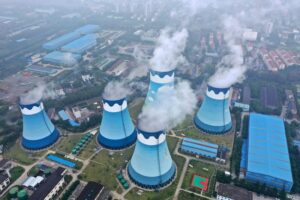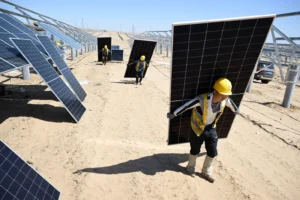
Explainer: How China is managing the rising energy demand from data centres
Yuan Ye
04.16.25Yuan Ye
16.04.2025 | 8:00amThe rise of artificial intelligence (AI) and other technologies has driven the “surging” growth of data centres in China, with associated increases in energy demand and emissions.
There were 449 data centres in China at the end of 2023, the most in the Asia-Pacific region.
The International Energy Agency (IEA) says in a new report that China accounted for 25% of global data-centre electricity consumption in 2024, the second largest consumer following the US.
In common with other countries, China expects the electricity consumption of its data centres to grow rapidly over the next few years, partly as a result of the rise of AI.
However, the scale of current demand – and any future increase – is uncertain.
For now, other drivers of rising electricity demand remain far more important than data centres.
Still, while estimates differ, some reports suggest data centre electricity demand could increase from around 100–200 terawatt-hours (TWh) in 2025 to as much as 600TWh by 2030, with associated emissions of 200m tonnes of carbon dioxide equivalent (MtCO2e).
China’s central and local governments have enacted a range of policies to address the environmental impacts of data centres, but challenges remain.
Growing electricity demand
China’s State Council posted a 2021 report from state-owned newspaper China Daily, which said the electricity consumption of China’s data centers in 2020 was 200TWh, some 2.7% of demand that year, rising to 400TWh (3.7%) by 2030. More recent government figures put demand at 77TWh in 2022, 150-200TWh in 2025 and 400TWh by 2030.
Sign up to Carbon Brief's free "China Briefing" email newsletter. All you need to know about the latest developments relating to China and climate change. Sent to your inbox every Thursday.
In early 2025, Bloomberg reported even higher estimates from Goldman Sachs, saying that data centre electricity demand in China was “expected to more than triple [from 200TWh today] to almost 600TWh by the end of the decade”.
In contrast, the IEA estimates Chinese data centre electricity demand of just 100TWh in 2024, with the potential to double by 2027.
Furthermore, data centres remain relatively small, both in terms of their share of China’s electricity demand overall and as a driver of demand growth.
Currently, data centres in China use between 0.9% and 2.7% of the country’s annual electricity, according to different estimates.
However, Bloomberg reports they use “less than a 10th” of the electricity required by the manufacturing sector, noting that demand from factories grew by 300TWh in 2024 alone.
The IEA says data centres have accounted for just 3% of new demand since 2022 – and will grow to perhaps 6% out to 2027. It says larger drivers of demand growth in China are industry, including industrial electrification, as well as electrification of heat and transport.
Still, the amount of CO2 associated with data centres could reach 1% of the country’s total emissions by the end of 2025, according to Han Xue, deputy director of the department of resource and environment policy at the Development Research Centre of the State Council.
Building ‘green data centres’
In 2021, China announced a three-year action plan to construct “new data centres” that are “efficient, clean, optimised and circular”.
The three-year action plan included measures to enhance data centres’ power usage effectiveness (PUE), the most widely used metric for gauging their energy efficiency.

The calculation is the total amount of energy used divided by IT equipment energy usage. The higher the ratio, the less energy efficient the data centre.
By the end of the action plan, the average PUE had been reduced to 1.48, down from 1.54 in the previous year.
The new goal, announced in 2024, was to cut the PUE of large data centres down to 1.25 by 2025. In comparison, Germany, which hosts the highest number of data centres in Europe, requires its existing data centres to reach an average PUE level of 1.5 from 2027.
Meanwhile, in 2022 China launched a long-awaited national project named “east data west computing” (东数西算), which aimed at processing data produced in the more populous eastern provinces in the west of China. It encourages new data centres to be built in the west, where large solar and windfarms are based, in order to assist the busy metropolis centres in the east.
Under the project, the data centres in central and western regions handle more of the non-realtime cloud computing needs, such as offline analysis and storage backup, while the time-sensitive data services continue to be met in the east.
Regional governments, such as Inner Mongolia in northern China, have also issued local policies encouraging data centres to be paired with renewable energy facilities.
Elsewhere, Beijing’s local government has provided financial support to data centres for improving their PUE. Meanwhile, Guangdong province, the southern technology hub, has opted to move some data centres undersea, in order to reduce the need for cooling technology and cut power use.
Since 2020, the Chinese government has tracked a range of information on data centres’ energy transitions. The latest update from 2024 said more than 50 data centres nationwide have met a standard for “green” energy requirement, including one from State Grid and 14 from the country’s internet companies.
Facing renewable challenges
By 2030, China’s data centres are projected to consume anything from 400TWh to 600TWh of electricity, with associated emissions of perhaps 200MtCO2e.
Currently, renewable resources in China are primarily distributed in the northern part of the country, while demand is still concentrated in the south-eastern coastal areas. This means that data centres often rely on long-distance transmission to use renewable power, even with efforts from the “east data west computing” programme.
“Green electricity has broad application prospects in the data centre industry, but it still faces many challenges,” says Lü Xin, project lead at Beijing-based thinktank Greenpeace East Asia.
Trading green power between provinces remains difficult due to factors such as variable renewable output and the high costs of long-distance transmission, according to several reports.
China has issued policies supporting direct transmission of renewable electricity to data centres and has established “green power industrial parks”, with dedicated renewable sources and storage.
“These policy developments and improved market mechanisms will bolster the adoption of green power by data centres,” says Lü.
Another challenge is the water demand of data centres. As they often require a lot of water for cooling, this could exacerbate water stress in the country’s already arid western and northern regions.
To alleviate the concern, governments in Beijing, Ningxia and Gansu are mandating higher water use efficiency for data centres, as well as phasing out the ones with low efficiency of power and water use.
As data centres expand to handle AI workloads, more “hyperscale” data centres with gigawatts of energy demands may emerge, demanding higher power capacity. A cleaner fuel mix in a country’s overall power structure can help to mitigate the emissions.
For now, however, data centres in China are at a “significant disadvantage from the emissions perspective”, due to the country’s reliance on coal, according to research firm SemiAnalysis.
Coal accounts for about 60.5% of China’s power mix. The IEA says most data centres in China are located in the east where about 70% of electricity supply is from coal, but the rise of renewables and nuclear power should ”push coal to decline” after 2030.
The report estimates that both renewables and nuclear will “together make up 60% of China’s data centre electricity supply” by 2035.




